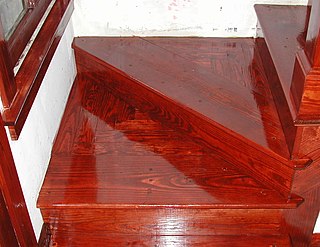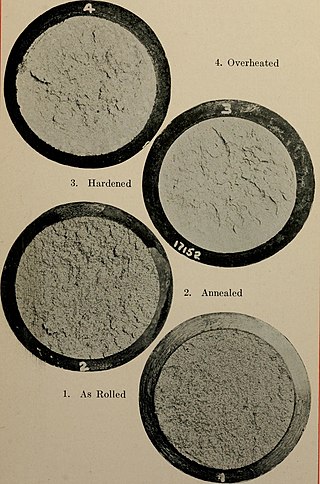
Oil painting is a painting method involving the procedure of painting with pigments with a medium of drying oil as the binder. It has been the most common technique for artistic painting on canvas, wood panel or copper for several centuries, spreading from Europe to the rest of the world. The advantages of oil for painting images include "greater flexibility, richer and denser colour, the use of layers, and a wider range from light to dark". But the process is slower, especially when one layer of paint needs to be allowed to dry before another is applied.

Copra is the dried, white flesh of the coconut from which coconut oil is extracted. Traditionally, the coconuts are sun-dried, especially for export, before the oil, also known as copra oil, is pressed out. The oil extracted from copra is rich in lauric acid, making it an important commodity in the preparation of lauryl alcohol, soaps, fatty acids, cosmetics, etc. and thus a lucrative product for many coconut-producing countries. The palatable oil cake, known as copra cake, obtained as a residue in the production of copra oil is used in animal feeds. The ground cake is known as coconut or copra meal.

Varnish is a clear transparent hard protective coating or film. It is not to be confused with wood stain. It usually has a yellowish shade due to the manufacturing process and materials used, but it may also be pigmented as desired. It is sold commercially in various shades.

Linseed oil, also known as flaxseed oil or flax oil, is a colourless to yellowish oil obtained from the dried, ripened seeds of the flax plant. The oil is obtained by pressing, sometimes followed by solvent extraction.

Tool steel is any of various carbon steels and alloy steels that are particularly well-suited to be made into tools and tooling, including cutting tools, dies, hand tools, knives, and others. Their suitability comes from their distinctive hardness, resistance to abrasion and deformation, and their ability to hold a cutting edge at elevated temperatures. As a result, tool steels are suited for use in the shaping of other materials, as for example in cutting, machining, stamping, or forging.

Oil paint is a type of slow-drying paint that consists of particles of pigment suspended in a drying oil, commonly linseed oil. For several centuries the oil painting has been perhaps the most prestigious form in Western art, but oil paint has many practical uses, mainly because it is waterproof.

A drying oil is an oil that hardens to a tough, solid film after a period of exposure to air, at room temperature. The oil hardens through a chemical reaction in which the components crosslink by the action of oxygen. Drying oils are a key component of oil paint and some varnishes. Some commonly used drying oils include linseed oil, tung oil, poppy seed oil, perilla oil, castor oil and walnut oil. Their use has declined over the past several decades, as they have been replaced by alkyd resins and other binders.
A paint marker is a type of marker pen that is used to create permanent writing on a variety of surfaces such as paper, metal, stone, rubber, plastic, and glass.
A binder or binding agent is any material or substance that holds or draws other materials together to form a cohesive whole mechanically, chemically, by adhesion or cohesion.

A chiffon cake is a very light cake made with vegetable oil, eggs, sugar, flour, baking powder, and flavorings. Being made with vegetable oil, instead of a traditional solid fat such as butter or shortening.
This article is a list of terms commonly used in the practice of metalworking – the science, art, industry, and craft of shaping metal.

A vacuum furnace is a type of furnace in which the product in the furnace is surrounded by a vacuum during processing. The absence of air or other gases prevents oxidation, heat loss from the product through convection, and removes a source of contamination. This enables the furnace to heat materials to temperatures as high as 3,000 °C (5,432 °F) with select materials. Maximum furnace temperatures and vacuum levels depend on melting points and vapor pressures of heated materials. Vacuum furnaces are used to carry out processes such as annealing, brazing, sintering and heat treatment with high consistency and low contamination.
A glaze is a thin transparent or semi-transparent layer on a painting which modifies the appearance of the underlying paint layer. Glazes can change the chroma, value, hue and texture of a surface. Glazes consist of a great amount of binding medium in relation to a very small amount of pigment. Drying time will depend on the amount and type of paint medium used in the glaze. The medium, base, or vehicle is the mixture to which the dry pigment is added. Different media can increase or decrease the rate at which oil paints dry.
A non-drying oil is an oil which does not harden and remains liquid when it is exposed to air. This is as opposed to a drying oil, which hardens completely, or a semi-drying oil, which partially hardens. Oils with an iodine number of less than 115 are considered non-drying.
An oil drying agent, also known as siccative, is a coordination compound that accelerates (catalyzes) the hardening of drying oils, often as they are used in oil-based paints. This so-called "drying" occurs through free-radical chemical crosslinking of the oils. The catalysts promote this free-radical autoxidation of the oils with air.
Chak-chak is a popular fried dough food in Tatarstan and Bashkortostan.

Tung oil or China wood oil is a drying oil obtained by pressing the seed from the nut of the tung tree. Tung oil hardens upon exposure to air, and the resulting coating is transparent and has a deep, almost wet look. Used mostly for finishing and protecting wood, after numerous coats, the finish can even look plastic-like. Related drying oils include linseed, safflower, poppy, and soybean oils. Raw tung oil tends to dry to a fine, wrinkled finish ; this property was used to make wrinkle finishes, usually by adding excess cobalt drier. To prevent wrinkling, the oil is heated to gas-proof it.

Rengginang or ranginang is a variety of Indonesian thick rice crackers, made from cooked glutinous sticky rice and seasoned with spices, made into a flat and rounded shape, and then sun-dried. The sun-dried rengginang is deep-fried with ample cooking oil to produce a crispy rice cracker.

Ampaw, ampao or arroz inflado, usually anglicized as pop rice or puffed rice, is a Filipino sweet puffed rice cake. It is traditionally made with sun-dried leftover cooked white rice that is fried and coated with syrup.

The oil print process is a photographic printmaking process that dates to the mid-19th century. Oil prints are made on paper on which a thick gelatin layer has been sensitized to light using dichromate salts. After the paper is exposed to light through a negative, the gelatin emulsion is treated in such a way that highly exposed areas take up an oil-based paint, forming the photographic image.












